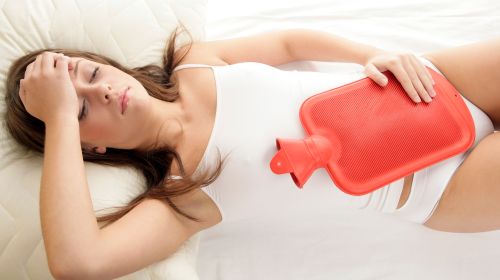If the gynecologist suggests scraping in the event of bleeding disorders or after a miscarriage, this is a routine procedure. When it is necessary to scrape the uterus, how it works and what to watch out for in the days after.
- The scraping of the uterus is now a routine operation.
- © iStock.com/RossHelen
The scraping of the uterus (medical abrasion uteri, curettage or curettage) is a generally uncomplicated gynecological operation that is recommended by gynecologists if there are various symptoms. The lining of the uterus is carefully removed with surgical instruments. This can also be used for diagnostic purposes, in order to examine the tissue removed from the uterine cavity for pathological changes.
Article content at a glance:
When it is necessary to scrape the uterus
In the course of the menstrual cycle, the lining of the uterus builds up under the influence of hormones and prepares itself for an egg cell to implant. If there is no fertilization after ovulation, the female body rejects the mucous membrane, which is well supplied with blood, and menstruation occurs. This normal, natural process of building and breaking down the uterine lining can be disturbed for various reasons.
Most often, a doctor will perform a scraping in the event of bleeding disorders. Prolonged, very heavy or painful menstrual periods as well as recurring bleeding during menopause can be diagnosed and treated at the same time.
The reasons for such bleeding disorders are varied and mostly harmless. Myomas (benign growths of the uterine muscles) and polyps can ensure that the uterus can no longer contract properly and the mucous membrane can be rejected. Malignant tumors of the uterine lining (endometrial carcinoma) are rarely the cause of the bleeding disorders.
Scraping after miscarriage and childbirth
A uterine scraping is often done after a miscarriage. This is to ensure that the embryo and placenta are completely rejected after a spontaneous discharge. Leftover tissue can lead to prolonged bleeding and infection.
Scraping is not absolutely necessary after a miscarriage, however. The indication for this depends on both the physical and mental state of the woman. If the patient decides against abrasion and natural rejection, she should pay close attention to physical symptoms such as pain, bleeding and fever and consult a doctor if they have symptoms.
After a natural birth, uterine scraping is sometimes necessary if the placenta has not completely separated from the inner wall of the uterine cavity.
A termination of pregnancy (abortion) – if it is not triggered with medication – is also carried out with such an intervention. In this case, the special method is called suction or suction curettage.
Preparation and procedure for scraping the uterus
Today, the procedure is usually performed on an outpatient basis in gynecological departments of hospitals or in gynecological practices. The patient is not aware of the procedure. The procedure can be performed under local anesthesia, but in Germany it is usually performed under a brief general anesthetic. To do this, the patient must be sober, six to eight hours before the operation she must not have eaten or taken any medication.
The scraping is carried out on the gynecological examination chair. The external genital area will be cleaned, possibly shaved and covered with sterile surgical drapes. The doctor then first inserts a speculum into the vagina to widen the cervix. The actual scraping of the uterus is carried out with a curette. With this spoon-like, more or less sharp-edged instrument, the doctor can carefully remove the uterine lining and, if necessary, material from the cervix. The tissue is picked up with an aspirator and sent to the laboratory for examination.
Suction instead of scraping during suction curettage
In the case of a surgical abortion, a suction curette is usually used instead of a spoon. The embryo and placenta are sucked out of the uterus with a blunt tube.
After the scraping, the doctor uses ultrasound to check whether the tissue has been completely removed. Alternatively, an endoscopy can be connected. An endoscope with a light source is inserted and the images from inside the uterus are transferred to a screen. The surgeon can inspect the uterine cavity, make sure that there are no more tissue residues, examine abnormal areas more closely and remove polyps.
Special form of abrasion: Fractional curettage
Fractional curettage is a special form of scraping. It is mainly carried out for diagnostic reasons, for example if abnormal findings from a Pap test or an ultrasound examination need to be examined more closely. During the procedure, tissue samples are first taken from the cervix, then samples are taken from the mucous membrane with a second curette.
This method is also used for endometrial biopsy, in which samples are taken from the anterior and posterior walls of the uterus.
What should you watch out for after scraping?
As a rule, scraping takes a maximum of 15 minutes. After the general anesthesia, the patient comes to in the recovery room and is observed there for some time. She can usually leave the practice or clinic on the same day. However, since the circulation has to get going again, it is advisable to be picked up or take a taxi home. It is better to do without your own car or public transport after the procedure.
In the first few days after the uterus has been scraped off, it is important to rest. Since the cervix slowly closes again, there is a risk that germs can penetrate the uterus and cause infections. That is why women should avoid full baths, saunas, swimming, tampons and sexual intercourse for two to three weeks after the abrasion.
Uterus: After scraping, light bleeding and pain are normal
The uterus itself must also recover after the procedure and the wound heal. Mild, pulling pain, easy bleeding for up to a week, and brownish discharge for up to two weeks after the procedure are normal.
The first menstrual period starts again after four to eight weeks. But even before this, pregnancy can occur, which is why contraception should be considered. The woman should become pregnant three months after the scraping at the earliest.
Possible complications after scraping
The uterine scraping is a routine procedure and complications are rare. The most common occurrences are bleeding and menstrual pain – this is normal and a sign that the uterus is regenerating.
Possible complications of an abrasion:
- strong pain
- Infections
- Bleeding
- fever
- Adhesions
- Injuries to the uterus and cervix
In the event of severe pain, bleeding and fever, the gynecologist should be consulted. These symptoms could be signs of an injury to the body of the uterus, infection, or retained tissue. Depending on the severity of the symptoms, treatment is carried out either with medication or with renewed scraping.
Adhesions in the area of the uterus and a weakening of the cervix are possible, but rarely, after a uterine scraping. These can increase the risk of infertility, miscarriages, and complications in later pregnancies.

